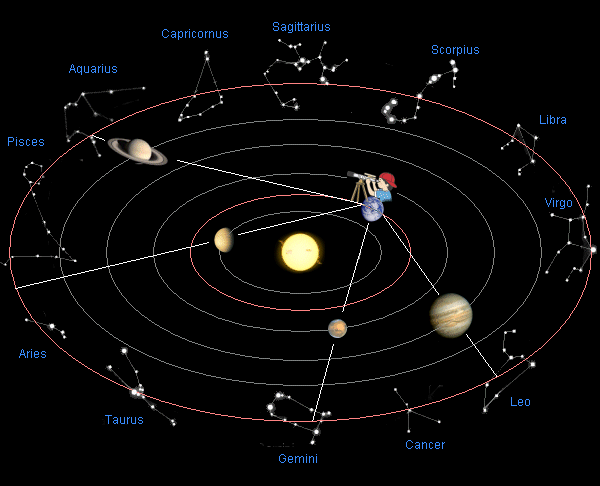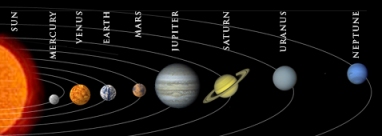Presented by Orbys Inc.
Fun Facts for Spica
 All Planets are on the same Arc in the Sky
All Planets are on the same Arc in the SkyDuring a year, the Sun appears to move on a path called the "Ecliptic" which leads through 12 constellations. These constellations are: Aquarius, Capricornus, Sagittarius, Scorpius, Libra, Virgo, Leo, Cancer, Gemini, Taurus, Aries, and Pisces.
Now, the ecliptic is the plane of Earth's orbit around the Sun, while the other seven planets are moving near the ecliptic which passes through the above 12 constellations.
So, you will find any planet somewhere in either constellation. A planisphere for your location will show you which constellations are currently up over the horizon.

Above an example to show why you see a certain planet in a certain constellation. Viewing from Earth, you see Saturn in the constellation of Aquarius and Jupiter in the constellation of Leo. The inner red circle is the ecliptic (Earth-Sun orbit), the outer is its imaginary extention towards the stars. For better understanding, the drawing is not to real scale.
Dear Parents
The scrollable star chart centered around the ecliptic shows the present actual positions of Sun, Moon and the brightest planets in the sky. The red grid represents equatorial coordinates, with right ascension 0 at the utmost right and declination 0 in the center. As you see, all solar system objects are near the yellow waveform line which represents the ecliptic path. Because the ecliptic is the orbital plane of Earth, the Sun is always exactly on it. With the help of this star chart you can also verify the 12 constellations along the ecliptic.
Star chart generated with StellaNavigator 8.1 planetarium software, AstroArts Inc.
Ephemerides computation by www.alfcen.com
The scrollable star chart centered around the ecliptic shows the present actual positions of Sun, Moon and the brightest planets in the sky. The red grid represents equatorial coordinates, with right ascension 0 at the utmost right and declination 0 in the center. As you see, all solar system objects are near the yellow waveform line which represents the ecliptic path. Because the ecliptic is the orbital plane of Earth, the Sun is always exactly on it. With the help of this star chart you can also verify the 12 constellations along the ecliptic.
Star chart generated with StellaNavigator 8.1 planetarium software, AstroArts Inc.
Ephemerides computation by www.alfcen.com
 Wandering Stars
Wandering Stars'Planet' means "wandering star", rightfully, because planets are moving around the Sun as Earth does, but in other distances and at different speeds. Planets orbiting between Earth and the Sun, also called "inner planets", are moving faster than planets beyond Earth, also called "outer planets". The closer a planet to the attracting force of the Sun the faster it moves and the quicker it changes its position in the sky.
If you see a bright "star" in a constellation which is not marked on your planisphere, then, you are obviously seeing a planet. Far away stars twinkle because they send their own light to us. Planets do not twinkle because they are illuminated by the Sun. Aim a torch at a ball in the dark and you will see that the ball is illuminated. Your torch is the Sun. In the same way planets receive sunlight thanks to which we can see them. With Spica, you can easily see the planets Venus, Mars, Jupiter and Saturn. The other planets are too faint or too far away for Spica.
 Planets within Spica's Reach
Planets within Spica's Reach To recognize a planet that Spica can see is fairly easy:
To recognize a planet that Spica can see is fairly easy: Venus is the second planet from the Sun. It does not show any surface details because it is enveloped by thick poisonous clouds of gas. Venus shows phases as our Moon and can be seen shortly after sunset in the west ("evening star") or before sunrise in the east ("morning star").
Mars is the fourth planet, smaller than Earth, and therefore very tiny to watch in Spica, but its reddish-orange color is prominent. That's why Mars is also called 'The Red Planet'. Mars has a solid surface which has been examined by Mars rovers.
Jupiter is the fifth and largest planet in our Solar System -- 'The King of Planets'. It is like a huge ball of gas and clouds without solid surface. Its four brightest moons named Io, Europa, Ganymede and Callisto have been discovered by Galileo Galilei as he first pointed his self-made telescope towards Jupiter -- just like you.
Well, and Saturn is the sixth planet and famous for its ring, most likely your favorite target for Spica. Like Jupiter there is no solid surface. Because of its beautiful, majestic ring, Saturn is also called 'The Lord of the Rings'. The ring consists of loose rocks up to house sizes.
 How Big is our Solar System?
How Big is our Solar System?Sizes, diameters and distances in space are often hard to imagine. Earth measures 12,756 km in diameter and the Sun is 150 million kilometers on average away from Earth. Well, these are big numbers and no fun to deal with. Let's shrink Earth to the size of a big ball of 1 meter in diameter and look again at our Solar System.
If Earth were just one meter in diameter, the Moon would be 30 meters away and 27cm large. The Sun would be 12 kilometers away and 109 meters in diameter. Now that's much easier. The sizes of the major planets: Mercury = 38cm, Venus = 95cm, Earth = 1 meter (of course), Mars = 53cm, Jupiter 11.2m and Saturn = 9.5m.
Observing Jupiter with Spica it is like seeing an 11.2 meters big ball in a distance of 60 kilometers. Or, a smaller ball of 9.5 meters in a distance of 112 kilometers, namely Saturn. That's quite impressive, isn't it?
 You are Galileo!
You are Galileo!
 Already 400 years ago, Galileo Galilei has observed all these bright planets with his small telescope and scribbled what he saw.
Your Spica is almost of the same structure, but of much better optical quality and you can see a six times wider sky in your eyepiece
than Galileo did in his. Nevertheless, Galileo Galilei set the landmark of the beginning of modern astronomy with telescopes, as Spica
will ignite your fascination with the Moon, the planets and the stars above.
Already 400 years ago, Galileo Galilei has observed all these bright planets with his small telescope and scribbled what he saw.
Your Spica is almost of the same structure, but of much better optical quality and you can see a six times wider sky in your eyepiece
than Galileo did in his. Nevertheless, Galileo Galilei set the landmark of the beginning of modern astronomy with telescopes, as Spica
will ignite your fascination with the Moon, the planets and the stars above.


